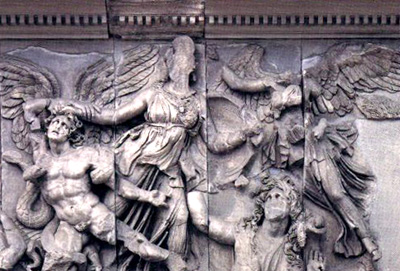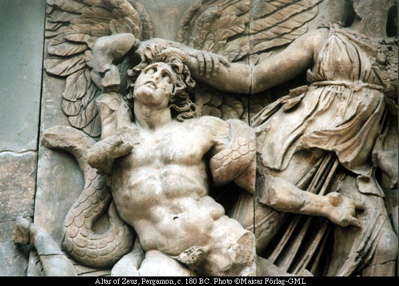by Amanda Bauer
“Gigantomachy,” one of the most popular myths in Greece, is a representation of battles between the Olympian gods and Giants in antiquity. According to the myth, the Giants attacked the gods, but the Olympians learned that they could only emerge victorious if a mortal helped them. The gods therefore called Heracles to aid them, and they won the battle.
Zeus, Heracles, Poseidon, and later Athena were the main protagonists fighting against the Giants in representations of this epic battle. In such representations the giants are represented as warriors, madmen, or snake monsters.
Some examples of representations of Gigantomachy are from the Altar of Zeus at Pergamon from the late 2nd century BCE. One of the scenes (pictured below) is of Athena battling the giant Alkyoneos. Athena grabs the hair of the giant as Nike (the goddess of Victory) flies down to crown the goddess victorious. Like in other scenes, the dying giant writhes in agony and his face is a mask of pain. The emotional faces and often contorted figures are exemplary of Hellenistic sculpture.

Athena battling the giant Alkyoneos

Detail of giant Alkyoneos
Gigantomachy scenes such as this symbolize the struggle between the cosmic order of the Olympians and the forces of chaos and/or barbarian outsiders. The battle of the gods against the Giants in Pergamon may therefore allude to the Pergamese victory over invading Gauls in the late 3rd century.
Another famous representation of Gigantomachy is found on the east metopes of the Parthenon. In this case, the scenes may represent the triumph of Athenian law and justice, fundamental to the success and order of the city-state. Also, the Parthenon was constructed shortly after the Athenian victory over the Persians in the 5th century, so it could also represent the defeat of barbarians (like the Altar of Zeus).
Works Cited:
Ed. Hornblower, Simon and Spawforth, Antony. The Oxford Companion to Classical Civilization. Oxford: Oxford University Press, 1998.
Kleiner, Fred S. and Mamiya, Chrisitin J. Gardener's Art Through the Ages. 12th ed. Belmont, CA: Thomson Learning Inc., 2005.
